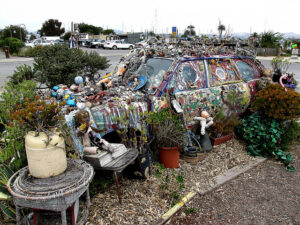I was talking to a young woman the other day who was not sure whether to call herself a feminist because she had heard that she needed to support certain causes in order to be a ‘real feminist.’ “If you believe in the full social, economic, political equality of women and men then you are a feminist,” I said.
I was reminded of Ruth Bader Ginsberg’s remarks on the Marriage Equality Act – full milk vs. skim milk and thought that the image was apt – a perception by some that there was a full milk feminism for those who ticked the boxes on a number of causes and a skim milk feminism for those who were challenged by some of these causes and campaigns and yet still believed in a rights based approach. It seemed that if women and men believed in a rights based approach to women claiming and realizing their rights – a right to education, a right to a childhood without early marriage, a right to work, a right to the choice of work, a right to protection from trafficking and abuse and a right to choices about our bodies – then there was room for a variety of views and voices to surface within the realm of feminism.
We didn’t need to look much further than to watch Ruth Bader Ginsberg last week to appreciate a feminist in thought and action. As an 80-year old Supreme Court Justice who is 5 feet tall, weighs less than 100 pounds and is a cancer survivor, the 20 push-ups she does twice weekly to keep fit are paying off for the heavy duty work she does in court. Especially during a case involving plaintiffs challenging the validity of the Defense of Marriage Act (DOMA) and the verbal play-off in court over the last week.
This was a debate brought about by an announcement on December 22nd 2010 by President Obama that the administration would no longer defend the constitutionality of DOMA, the federal law banning recognition of same-sex marriage. Attorney General Eric Holder noted that the congressional debate during passage of the Defense of Marriage Act “contains numerous expressions reflecting moral disapproval of gays and lesbians and their intimate and family relationships – precisely the kind of stereotype-based thinking and animus the (Constitution’s) Equal Protection Clause is designed to guard against.” In fact, Justice Elena Kagan pointed out that in 1996, Congress decided to reflect a collective moral judgment, and to express moral disapproval of homosexuality.
In 2012, civil rights advocate and lawyer Mary Bounauto, whose legal work over the past 23 years was the catalyst for creating civil unions and for same sex marriage being legalized in Massachusetts, persuaded a federal appeals court that DOMA was unconstitutional which led to the hearing in the Supreme Court last week.
That left the House Republicans, led by John Boehner, to defend DOMA with taxpayer money. They hired a conservative lawyer named Paul Clement to argue to uphold the law and to deny that it was discrimination at play, with a view that the law was focused on maintaining the status quo.
So, in a dialogue between Paul Clement and Justice Ginsburg, this is what played out in the US Supreme Court last week as Paul Clement made his case for the DOMA law to be retained:
JUSTICE RUTH BADER GINSBURG, U.S. SUPREME COURT: Mr. Clement, the problem is that it would totally thwart the states` decision that there is a marriage between two people for the federal government then to come in and say, no joint return, no marital deduction, no Social Security benefits. Your spouse is very sick, but you can`t get leave. People — with that set of attributes, one might well ask, what kind of marriage is this?
PAUL CLEMENT, ATTORNEY: And I think the answer to that, Justice Ginsburg, would be to say that that`s a marriage under state law. No state loses any benefits by recognizing same-sex marriage. Things stay the same. What they don`t do is they don`t sort of open up an additional class of beneficiaries under their state law that get additional federal benefits. But things stay the same. And that`s why in this sense —
GINSBURG: They`re not — they`re not a question of additional benefits. I mean, they touch every aspect of life. Your partner is sick. Social Security, I mean, it`s pervasive. It`s not as though there`s this little federal sphere and it`s only a tax question. It`s — as Justice Kennedy said, 1,100 statutes, and it affects every area of life. And so you`re really diminishing what the state has said is marriage. You`re saying, no, states have two kinds of marriages; the full marriage, and then a sort of skim milk marriage.
Ginsberg articulated the logical conclusion of Clement’s argument – a justification for second class citizenship for same sex couples as compared to full citizenship for others.
This second class citizenship had been felt by many same sex couples. When Edie Windsor and Thea Spire got married in 2007, they had already been together for over 42 years. Spire by then had advanced Multiple Sclerosis and had been told she had less than a year to live. So Edie and Thea flew to Toronto and got married then, not long after this, Spire died. And because of the Defense of Marriage Act, in death, Thea Spire was not recognized as having a surviving spouse – Edie Windsor was in effect seen as a stranger rather than family before the law.
Roberta Kaplan, the human rights lawyer presenting the case for same sex couples rights side, said that “as the title of the statute makes clear, DOMA was enacted to defend against the marriages of gay people. This discriminatory purpose was rooted in moral disapproval.” The maintenance of DOMA was a continuation of this moral judgment and the crux of why Roberta Kaplan and Paul Clement were before the US Supreme Court.
This exchange between Justice Stephen Breyer and Roberta Kaplan is telling:
JUSTICE STEPHEN BREYER, U.S. SUPREME COURT: — the argument that I heard was to put the other side, at least one part of it, as I understand it, look, the federal government needs a uniform rule. There has been this uniform one man-one woman rule for several hundred years, whatever, and there`s a revolution going on in the states. We either adopt the revolution or push it along a little, or we stay out of it. And I think Mr. Clement was saying, well, we`ve decided to stay out of it. The way to stay out is to go with the traditional thing. That`s an argument. So your answer is what?
KAPLAN: I think that`s an incorrect argument.
BREYER: I understand you do. I`d like to know the reason.
KAPLAN: Of course, Congress did not stay out of it. Section three of DOMA is not staying out of it. Section three of DOMA is stopping the recognition by the federal government of couples who are already married solely based on their sexual orientation, and what it`s doing is undermining …the policy decisions by those states that have permitted gay couples to marry — states that have already resolved the political, moral, whatever other controversies that are resolved in those states. And by fencing those couples off, couples who are already married and treating them as unmarried for the purposes of federal law, you`re not taking it one step at a time, you`re not promoting caution. You`re putting a stop button on it and you`re having discrimination for the first time in our nation`s history against a class of married couples.
Chief Justice John Roberts weighed in with his own reflection of what he described as a sea change in public policy influenced by powerful lobbyists and lawyers engaged by the gay rights lobby, and by politicians wanting to be on the right side of history. Kaplan responded thus:
KAPLAN: The fact of the matter is, Mr. Chief Justice, is that no other group in history has been subjected to popular referenda to take away rights that have already been given or to exclude those rights the way gay people have. And only two of those referenda have ever lost. One was in Arizona; it then passed a couple of years later. One was in Minnesota where they already have a statute on the books that prohibits marriages between gay people. So I don`t think — and until 1990, gay people were not allowed to enter this country. So, I don`t think that the political power of gay people today could possibly be seen within that framework…”
In June, when a ruling is expected, if the Supreme Court strikes down DOMA then same-sex couples who are legally married in their state will now be treated like other married couples. And that will be a victory for everyone who believes in justice and in a Constitution that protects people’s rights.
This weekend I went to watch a colleague be confirmed into the Catholic Church. Those being confirmed are asked to choose their own middle name, which must be a Christian name – one of the Saints or from the Bible – since their birth name is not one they have chosen. My colleague chose Hildegard as the Saint she wanted to embrace due to Hildegard’s strong feminist spirit. Hildegard was a Christian mystic, abbess, visionary, and composer. She began wearing the Benedictine habit at the age of 15, and by the age of 38, she had been elected by her fellow nuns to serve as their magistra. The Ordo Virtutum is an example of her dramatic liturgical compositions.
Not only did Hildegard apparently receive revelation from heaven in her visions, she also engaged in serious and sustained observation of nature, using what she learned in service of the healing arts. In fact, hers are the only surviving medical treatises from the twelfth century. Hildegard’s vision of the cosmos and of our place within the cosmos is integral, seeing humans as microcosm of the macrocosm, and so her prescriptions for various conditions sought to remedy imbalances caused by our failure to live in harmony with nature.
So, at an evening candlelit vigil — a Service of Light — which began with a bonfire and ended with candles held high to the harmony of choral voices, my friend and co-worker was confirmed into the Catholic church and a new journey for her began.
 Back in Sausalito, I hung out with the boat people and loved my ambling walks along the shoreline to the constant tinkling of boat bells. My regular walk took me past letterboxes painted with water scenes, a fabulous art car and houseboats that in some sections looked more reminiscent of Kashmir than California.
Back in Sausalito, I hung out with the boat people and loved my ambling walks along the shoreline to the constant tinkling of boat bells. My regular walk took me past letterboxes painted with water scenes, a fabulous art car and houseboats that in some sections looked more reminiscent of Kashmir than California.
I sat on a wooden bench near rows of seedlings and watched a man with his old slow dog ease themselves into a blue canoe. It seemed like poetry in motion as the dog sat at the front of the canoe while the man sat at the back paddling toward the middle harbor and onward to the Golden Gate.

It reminded me of the kind of painting my friend, Helen Norton, would paint – in celebration of humans and their dogs and of that kinship with nature. I watched man and dog and blue canoe until they were but specks on the waves and then I suddenly stood up and waved – too late perhaps but I wanted them to know I saw them, I felt kin with them.
Jane Sloane – San Francisco